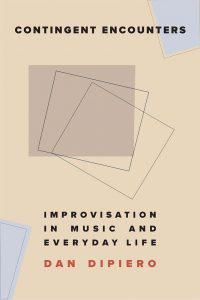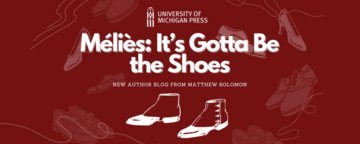Q&A with Dan DiPiero, Author of "Contingent Encounters"

This guest author post is a Q&A with Dan DiPiero, author of Contingent Encounters: Improvisation in Music and Everyday Life , from the University of Michigan Press. This book is available in hardcover, paper, and open access.
What surprised you the most while conducting your research for the book?
One thing that surprised me was how many references I could find to improvisation in the media. For years, I had been casually collecting examples any time I saw the word “improvisation” out in the world, for example on a billboard. But it was really when I started writing the introduction that I went actively looking for it. And once I did, it was much more ubiquitous than I had imagined. A lot of the cases I found exist in the context of business consulting; improvisation is a kind of buzzword in a lot of the business world, where it gets branded as something of a silver bullet that will allow employees to think more creatively and solve problems in real-time—so long as they are properly trained. To me, this oddly mirrors the attitude of many scholars interested in improvisation, who treat the concept as a promising modality for enhancing empathetic connections, communication, or open-mindedness.
How does your own experience performing influence your research?
There are many ways in which my musical experience directly informs my research. Of course, having experience playing improvised music with other people helps me to think about performance dynamics and the cultures that inform them. But even more broadly, a lot of the conceptual questions with which I started this project came out of playing music. Probably the most direct example, which I talk about briefly in the book, is this performance that I did in 2016 where we were supposed to be playing a through-composed tune with no improvisation whatsoever—and yet, in the performance, we ended up improvising anyway, for quite a long time.
In contrast to a straight-ahead jazz situation, for example, analyzing a situation like that felt like it required a different set of questions because we weren’t supposed to be improvising; there was something external to the music—external to the artistic intentions of the performers, and the negotiation of those intentions among peers—that fundamentally altered what we thought we were doing in that moment. Thinking about that example really helped me to articulate why I felt that contingency was such a productive term for framing improvisation—both what it is and what it does. It helped me to conceptualize the difference between internal and external contingencies, and to insist on an expanded understanding of how “external factors” partially constitute the sounds that we make with others.
Why did you choose these musicians to focus on? What can we learn from them?
There are some overarching and then more specific reasons for focusing on the artists that I did. In terms of overall themes, I was really looking for artists who could all be considered to belong in the Western/avant-garde/improvised music space—although that category has to be taken with a rather large disclaimer, because of how differently each artist thinks about their music, and how singular the results are. The reasons I was looking for artists in this lineage are twofold: first, because that is the musical world that I come from, and with which I’m most familiar. As I wrote above, that obviously helps with the analysis. But more importantly, I also wanted to think about those kinds of musicians because it is most often exactly those kinds of artists who are the focus of progressive improvisation studies. Insofar as I am trying to push back against progressive or utopian readings of improvisation, returning to “the source” of those arguments becomes a means of more thoroughly undermining them.
In terms of the particular artists, I chose each case because of how different they are from one another—even within this kind of free improvisation category—and because of the unique social factors that they can help readers to think about. For example, Eric Dolphy’s eccentric improvisations help us to think about the discursive construction of the Black avant-garde in the 1960s, and the ways that his music was subject to a kind of policing that was informed by race. With Mr. K, I remain fascinated by the way that “Waves, Linens, and White Light” completely contradicts many of the most persistent tropes about improvisation—that it is characterized by novelty or unpredictability—because of how thoroughly repetitive it is. It’s a completely improvised performance with only the subtlest variations, a full commitment and fidelity to one idea in a moment.
I also think that this performance indicates something important about the pedagogical backgrounds of the performers, who learned how to improvise in a Norwegian conservatory that differs substantially in terms of the predominant mode of jazz education in the U. S. I suggest that we can hear these differences in Mr. K’s playing—that the band’s training is in some sense audible. Finally, the Kris Davis/Ingrid Laubrock duo is such a rich performance for thinking through improvisation as deep collaboration, as a practice of intimacy, care, and artistic vision between two longtime friends. And because of the way that care practices are intertwined with feminist politics, this chapter spends some time thinking about the embodied performance of music, and how we bring our whole selves to a performance. I don’t think that one can speak about improvisation without attending to the ways in which these social factors inform and partially constitute the “sounds themselves.”
What are some of the ways that improvisation shows up in everyday life?
For me, it’s less that improvisation shows up in everyday life and more that improvisation is how we make everyday life in the first place. In other words, it’s the mode through which we engage the world. This follows from my claim that improvisation is simply what happens in a contingent situation: since we’re always dealing with contingency of one kind or another, we’re always improvising. That said, in the book I talk about a few specific examples in order to sort of polemically locate improvisation where it’s seldom assumed to be: those most repetitive, most mundane, most banal moments that nevertheless are flush with indeterminacies. So for example, I start with a discussion of walking through the city, which Michel de Certeau talks about through the language of improvisation. I also talk about baking, listening, working, and even perceiving as everyday practices that are contingent on time, place, and context, as well as the set of aptitudes, experiences, and moods that we bring to each situation of which we are a part.
Everyday life is so often associated with that which is routine, habitual, boring, or trivial. Improvisation is so often associated with that which is novel, exciting, unanticipated, and revelatory. My task in the second half of the book is to show how these ostensibly opposed concepts are in fact deeply wrapped up in one another—that, in an important sense, improvisation and everyday life are analogous.
While our everyday improvisations can indeed be beautiful, there is nothing necessarily romantic or poignant about claiming that everyday life is improvised. In fact, contemporary life in the U. S. is characterized by an increasing mandate to improvise in the face of collapsing institutional and structural supports. With no public healthcare, anemic retirement options, decades-old infrastructures, ever decreasing support for education, and other attacks on the very notion of the public sphere, improvisation becomes a word for necessary recourse in the absence of dependable supports—a synonym for scrambling, flailing (as Lauren Berlant put it), and community support efforts with which the wealthy need not be bothered.
What do you hope readers will take away from reading Contingent Encounters?
I have so many hopes for this book! First of all, I hope people enjoy reading it—one thing that I tried to do was write in a compelling way. On one level, that’s an obvious thing to say. But what I mean is that I tried to write in a way that would reflect my investments and scholarly values. I hope that comes across to readers and makes the reading experience gratifying.
In terms of conclusions, I do hope that the book reframes how we approach improvisation as a concept. If it becomes a little more difficult to make progressive claims on behalf of improvisation as a result, I think that would be a worthwhile outcome. That’s not because I’m trying to advance a nihilistic or reactionary viewpoint; it’s because I think that improvisation often obscures what matters in a given context, the people and the circumstances that make improvisation whatever it is. So to the extent that this book redirects attention away from the activity of improvising and towards what actually matters, I think that would be a great takeaway. Perhaps my wildest hope is that one would have to contend with the sort of challenge I lay out in the book before theorizing (with/through) improvisation in the future.
Methodologically, I also hope the book brings work from feminist, queer, and critical race studies into conversation with improvisation scholarship a little bit more thoroughly. That kind of work is definitely out there—but it’s constantly competing with scholarship that treats improvisation, music, and sound as ontological or philosophical problems, without attending to what we might call “the social”—the radically contingent, situated, and social factors that are ultimately critical for understanding anything about what’s going on.
More narrowly, for those in musicology and jazz studies, I hope my case studies are valuable contributions to the literature. For those working in sociology and everyday life studies, I hope the book provides some helpful theoretical language for thinking through longstanding problems with the structure/agency binary. Finally, I hope that the book bridges a gap between musicology and cultural studies broadly, raising issues of shared concern, and showing how contingency can be a productive framework in both cases, where my idea of “musical improvisation” might help us to attend to our own improvising in new ways.



